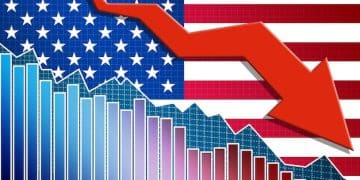New Corporate Tax Rate: Impact on US Business Investments in 2025?

The potential impact of a new corporate tax rate in 2025 on US business investments is a complex issue, with economists and industry leaders debating whether changes could stimulate or stifle growth, emphasizing the critical role of specific policy design and broader economic conditions in shaping outcomes.
The landscape of corporate taxation is constantly shifting, and with 2025 on the horizon, many businesses and investors are keenly asking: Is the New Corporate Tax Rate Impacting US Business Investments in 2025? This question delves into more than just numbers; it probes the very core of economic incentives, strategic planning, and the future trajectory of the American economy. Understanding the nuances of potential tax revisions and their ripple effects is paramount for anyone navigating the intricate world of finance and business.
Understanding the Current US Corporate Tax Landscape
Before delving into future projections, it is essential to grasp the current corporate tax structure in the United States. Since the Tax Cuts and Jobs Act (TCJA) of 2017, the federal corporate income tax rate has been set at a flat 21%. This represented a significant reduction from the previous top rate of 35%, aiming to make the US more competitive globally and encourage domestic investment.
The TCJA had several other key provisions beyond the headline rate reduction. It introduced a territorial tax system for multinational corporations, meaning that foreign-earned profits were largely exempt from US federal taxes, preventing double taxation. Additionally, it allowed for immediate expensing of certain capital investments, a provision often lauded for encouraging businesses to invest in new equipment and technology.
Historical Context of Corporate Taxation
Corporate tax rates in the US have a rich and varied history. For decades, the system was characterized by graduated rates, with larger corporations paying a higher percentage of their profits. The move to a flat rate in 2017 was a dramatic shift, reflecting a broader global trend towards lower corporate tax burdens. This historical perspective is crucial because it illustrates that tax policy is rarely static and often evolves in response to economic pressures, political ideologies, and global competitiveness.
The current 21% rate has now been in effect for several years, providing a substantial dataset to analyze its impact. While proponents argue it spurred economic growth and brought corporate profits back to the US, critics point to increased national debt and argue that benefits disproportionately favored shareholders and executives over workers. These debates lay the groundwork for any future discussions about rate adjustments.
- 2017 TCJA: Reduced federal corporate tax rate from 35% to 21%.
- Territorial System: Eliminated double taxation on foreign-earned profits.
- Immediate Expensing: Allowed businesses to deduct full cost of capital investments.
- Economic Impact: Debates on effects on growth, wages, and national debt.
Understanding these foundational elements is crucial because any new corporate tax rate in 2025 will inevitably be measured against the current framework, both in terms of its direct financial implications and its broader economic philosophy.
Proposed Changes to Corporate Tax Rates for 2025
As 2025 draws nearer, discussions around potential adjustments to the US corporate tax rate are gaining momentum. Several proposals have emerged from different political factions and economic think tanks, each with distinct philosophies and intended outcomes. The most prominent suggestion involves raising the corporate tax rate from the current 21% to a higher percentage, with figures ranging from 25% to 28% frequently cited.
The motivations behind these proposed increases are multifaceted. For some, it’s about addressing income inequality and ensuring that large corporations pay a “fair share.” Others view it as a necessary measure to fund critical public expenditures, such as infrastructure projects, social programs, or to reduce the national deficit. There’s also an argument that the 21% rate may have gone too far in reducing government revenue without delivering the promised economic benefits for all segments of society.
Arguments for and Against an Increase
Proponents of a higher corporate tax rate often argue that it would create a more equitable tax system and generate substantial revenue for public investment. They might point to historical periods of higher corporate taxes that coincided with robust economic growth and argue that the current lower rate benefits primarily shareholders rather than stimulating broader economic activity. There’s also a belief that large corporations have the capacity to absorb a higher tax burden without significantly impacting their investment decisions or competitiveness.
Conversely, opponents warn that raising the corporate tax rate could severely undermine US competitiveness, particularly in a global economy where many countries vie for corporate investment. They argue that higher taxes act as a disincentive for businesses to expand, innovate, and create jobs domestically. Instead, companies might choose to relocate operations, defer investments, or reduce R&D spending, ultimately harming the US economy. The fear is that a higher rate could negate the very incentives that the TCJA aimed to establish.
- Proposed Range: Often cited increases to 25-28%.
- Key Motivations: Equity, funding public spending, deficit reduction.
- Pro-Increase Arguments: Fair share, revenue generation, historical precedent.
- Anti-Increase Arguments: Reduced competitiveness, stifled investment, job losses.
These arguments highlight the complex balancing act policymakers face. Any change to the corporate tax rate in 2025 will involve weighing the perceived benefits of increased revenue and fairness against the potential risks of deterring business investment and hindering economic growth.

Direct Impacts on Business Investment Decisions
The relationship between corporate tax rates and business investment is a cornerstone of economic theory. When a company considers investing in new factories, equipment, or research and development, the after-tax return on that investment is a critical factor. A higher corporate tax rate, all else being equal, reduces the net profit from an investment, thereby potentially making it less attractive.
This direct impact manifests in several ways. For instance, businesses might re-evaluate the profitability of long-term capital projects. If the projected returns are diminished by a higher tax burden, projects that were marginally viable at a 21% rate might become unfeasible at a 25% or 28% rate. This could lead to a slowdown in expansion plans, particularly for companies operating with tighter margins or those heavily reliant on significant capital expenditures.
Capital Expenditure and R&D
Capital expenditure (CapEx) is often one of the first areas to feel the pinch of increased tax rates. Companies might delay upgrades to machinery, postpone building new facilities, or scale back infrastructure projects. These decisions have a ripple effect throughout the economy, impacting suppliers, construction workers, and technology providers. The immediate expensing provision introduced by the TCJA further complicates this, as any changes to that specific tax break would compound the effective rate increase.
Similarly, research and development (R&D) investments, crucial for innovation and long-term competitiveness, could be affected. R&D projects are inherently risky, and their successful outcomes often depend on significant upfront outlays. If the potential future profits from successful R&D are taxed at a higher rate, companies might become more risk-averse, opting for less ambitious projects or even relocating R&D activities to more tax-friendly jurisdictions. This could have profound long-term implications for a nation’s innovative capacity.
- Profitability Assessment: Higher taxes reduce after-tax returns on investments.
- Delayed Projects: Marginally viable projects may become unfeasible.
- CapEx Reductions: Less investment in new equipment, facilities, and infrastructure.
- R&D Impact: Potential for reduced innovation and relocation of research centers.
These direct impacts underscore why changes to the corporate tax rate are rarely seen in isolation. They have tangible consequences for how businesses allocate capital, which, in turn, influences job creation, economic growth, and global competitiveness.
Indirect Effects on the US Economy and Global Competitiveness
Beyond the immediate considerations of capital and R&D, a new corporate tax rate in 2025 could trigger a cascade of indirect effects across the US economy and significantly alter its global standing. These effects are often more subtle but can be equally profound, shaping long-term trends in employment, market behavior, and international trade relations.
One primary indirect effect relates to the stock market and investor confidence. Changes in corporate tax rates directly impact corporate earnings, which are a key driver of stock valuations. If earnings are projected to decrease due to higher taxes, investor sentiment could sour, potentially leading to market corrections or a slowdown in new listings and capital raises. This could dampen the broader financing environment for businesses, making it harder for both established companies and startups to secure funding for growth.
Impact on Wages and Employment
The relationship between corporate taxes and wages is a subject of ongoing debate among economists. Some argue that a significant portion of the corporate tax burden is ultimately borne by workers in the form of lower wages or fewer job opportunities. If companies face higher tax liabilities, they might respond by slowing down hiring, offering less competitive salaries, or automating tasks traditionally performed by human labor to cut costs. Conversely, proponents of higher taxes might argue that the additional revenue collected can be reinvested in public services that ultimately benefit workers and the economy as a whole.
Furthermore, a new corporate tax rate can influence global competitiveness. If the US corporate tax rate becomes significantly higher than that of other major economies, it could incentivize multinational corporations to shift profits, investments, and even headquarters to countries with more favorable tax regimes. This phenomenon, known as “tax inversion” or “profit shifting,” could lead to a loss of tax revenue for the US and a reduction in domestic economic activity. Maintaining a competitive tax rate is crucial for attracting and retaining businesses in an increasingly globalized marketplace.
- Stock Market Response: Potential for reduced valuations and investor confidence.
- Financing Environment: Harder for businesses to raise capital for growth.
- Wage and Employment Levels: Debates on whether higher taxes lead to lower wages or reduced hiring.
- Global Profit Shifting: Risk of companies relocating investments to lower-tax jurisdictions.
These indirect consequences highlight that tax policy is not just about government revenue; it’s a powerful tool with far-reaching implications for the entire economic ecosystem, touching everything from individual livelihoods to the nation’s standing on the world stage.
Industry-Specific Analysis of Tax Rate Changes
While a new corporate tax rate would impact the overall US economy, its effects are rarely uniform across all sectors. Different industries have varying capital requirements, profit margins, and global exposures, making them more or less sensitive to changes in tax policy. A nuanced analysis requires examining how specific sectors might respond to a potential tax hike in 2025.
High-growth, capital-intensive industries, such as manufacturing, technology, and biotechnology, could be particularly sensitive. These sectors often rely heavily on significant upfront investments in R&D, advanced machinery, and infrastructure. If their after-tax returns diminish, the incentive to undertake risky, long-term projects—which are essential for their growth and innovation—could be severely curtailed. For example, a tech company might reconsider building a new data center, or a pharmaceutical firm might scale back its drug discovery programs.
Services and Retail Sectors
Conversely, service-oriented industries, which typically have lower capital expenditure requirements and often operate with more localized revenue streams, might experience a comparatively milder direct impact from a corporate tax rate increase. Retail, hospitality, and many professional services firms might primarily see an impact on their net profits, but their fundamental operating models might be less disrupted than those of manufacturing or technology giants. However, even these sectors could face indirect effects if consumer spending is dampened by broader economic slowdowns or if their business clients reduce spending due to their own tax burdens.
Multinational corporations across all sectors face unique challenges. For these entities, changes to the US corporate tax rate are part of a larger global tax strategy. If the US rate becomes less competitive, these companies might accelerate efforts to reallocate profits or even physical operations to countries with more attractive tax regimes. This global mobility of capital and talent means that US tax policy needs to be considered in a broader international context to avoid unintended consequences.
- Capital-Intensive Industries: Manufacturing, tech, biotech highly sensitive to R&D and CapEx costs.
- Services and Retail: Potentially milder direct impact but vulnerable to indirect economic shifts.
- Multinational Corporations: Increased incentive to shift profits or operations globally.
- Sector-Specific Policies: Need for tailored consideration of industry nuances.
Therefore, any new corporate tax rate must be evaluated not just for its aggregate economic impact, but also for its granular effects on the diverse array of industries that constitute the American business landscape. A one-size-fits-all approach risks disproportionately burdening some sectors while potentially having minimal impact on others.
Expert Opinions and Economic Projections
The debate surrounding a new corporate tax rate in 2025 is not confined to political rhetoric; it is actively shaped by a range of expert opinions and sophisticated economic projections. Economists, industry leaders, and think tanks employ various models and historical data to forecast the potential impacts, although their conclusions often diverge based on underlying assumptions and ideological perspectives.
Many academic economists utilize complex macroeconomic models to estimate the effects of tax changes on GDP, investment, wages, and employment. These models often consider factors such as consumer behavior, international capital flows, and government spending. One school of thought, often associated with supply-side economics, predicts that higher corporate taxes will inevitably lead to reduced investment and slower growth, as businesses face disincentives to expand. They emphasize the importance of keeping tax burdens low to stimulate private sector activity.
Perspective from Business Leaders
Business leaders, particularly from large corporations and lobbying groups, frequently express concerns about tax increases. They argue that higher taxes will reduce their ability to compete globally, force them to cut jobs, and stifle innovation. Their perspective often emphasizes the practical challenges of allocating capital in a high-tax environment and the potential for a “race to the bottom” where companies seek friendlier tax jurisdictions.
Conversely, other economists and policy advocates argue that the impact of corporate tax rate changes on investment is often overstated. They might suggest that other factors, such as market demand, technological advancements, and regulatory stability, play a more dominant role in investment decisions. They also point to the potential for increased government revenue from higher taxes to fund public goods and services that ultimately enhance productivity and attract investment in the long run. These experts often highlight that businesses consider a multitude of factors beyond just the headline tax rate when making long-term strategic decisions.
- Academic Models: Forecasting GDP, investment, wages, and employment changes.
- Supply-Side View: Higher taxes reduce investment and growth.
- Business Concerns: Reduced global competitiveness, job cuts, stifled innovation.
- Alternative Viewpoints: Investment driven by market demand, technology, and regulatory stability.
The diversity of these expert opinions underscores the complexity of forecasting economic outcomes. Any credible assessment of the 2025 corporate tax rate’s impact must consider this range of perspectives and the uncertainties inherent in economic prediction.

Mitigating Risks and Optimizing for Future Tax Landscapes
Regardless of the specific corporate tax rate that materializes in 2025, businesses and policymakers alike will need to focus on strategies for mitigating potential risks and optimizing for the evolving tax landscape. For businesses, this means proactive planning, dynamic financial modeling, and a keen understanding of both domestic and international tax implications.
One critical strategy for businesses involves diversifying investment strategies. Companies that are overly reliant on a single market or type of investment may be more vulnerable to tax changes. By exploring opportunities in various regions or asset classes, businesses can spread risk and potentially find more favorable tax environments for certain activities. This might involve expanding into countries with lower corporate tax rates for specific operations or investing in tax-advantaged instruments.
Role of Policy Design
For policymakers, the challenge lies in designing a tax structure that balances revenue generation with economic growth incentives. This is not simply about the headline corporate tax rate, but also about the broader tax code. Considerations include the treatment of R&D expenses, depreciation rules for capital investments, and provisions for international earnings. A well-designed tax policy seeks to avoid unintended consequences, such as discouraging innovation or driving businesses offshore, while still ensuring adequate public funding.
Furthermore, clear communication and a stable regulatory environment are paramount. Businesses thrive on predictability. Frequent or sudden changes to tax policy create uncertainty, which can be as detrimental to investment as a high tax rate itself. Policymakers should strive for consistency and provide ample notice for any significant tax reforms, allowing businesses sufficient time to adjust their strategies and financial plans. This stability fosters confidence and encourages long-term commitments.
- Business Proactivity: Diversify investments, dynamic financial modeling, understand international tax.
- Policy Balance: Design tax structure that balances revenue with growth incentives.
- Broader Tax Code: Focus on R&D, depreciation, and international earnings provisions.
- Stability and Communication: Clear, consistent policy to foster business confidence.
Ultimately, a collaborative approach between government and the private sector, along with a focus on comprehensive policy design, will be essential to navigate the complexities of any new corporate tax rate in 2025. The goal should be to create an environment that encourages sustainable business growth and long-term economic prosperity.
| Key Point | Brief Description |
|---|---|
| 📊 Current Rate | US federal corporate tax rate is 21% from TCJA 2017, down from 35%. |
| 📈 Proposed Changes | Proposals range from 25% to 28%, driven by equity and revenue needs. |
| 📉 Investment Impact | Higher taxes could reduce after-tax returns, potentially stifling CapEx and R&D. |
| 🌍 Global View | Competitiveness with other nations is crucial, affecting profit shifting and job creation. |
Frequently Asked Questions
The current federal corporate tax rate in the United States is a flat 21%. This rate was established by the Tax Cuts and Jobs Act (TCJA) of 2017, significantly reducing it from the previous top rate of 35%. This change aimed to enhance US competitiveness globally and encourage domestic corporate investment and growth.
Discussions for new corporate tax rates in 2025 are driven by several factors, including calls for increased tax equity, the need to fund public expenditures like infrastructure and social programs, and efforts to reduce the national deficit. Some policymakers believe the current rate may be too low to meet these financial and societal goals effectively.
A higher corporate tax rate could reduce the after-tax profitability of investments, making new capital expenditures and R&D projects less attractive. This might lead businesses to delay or scale back expansion plans, potentially resulting in slower economic growth, reduced job creation, and a decline in overall innovation within the US market.
Yes, significantly. If the US corporate tax rate becomes notably higher than those in other major economies, it could incentivize multinational corporations to shift profits, investments, and even operational bases to countries with more favorable tax regimes. This could diminish the US’s ability to attract foreign investment and retain domestic businesses, affecting its global standing.
Beyond the direct tax rate, business investment decisions are heavily influenced by market demand, technological advancements, regulatory stability, and access to skilled labor. Economic certainty, infrastructure quality, and the overall business environment also play crucial roles. A holistic view is essential as tax policy is just one piece of a complex investment puzzle for companies.
Conclusion
The question of whether a new corporate tax rate will impact US business investments in 2025 is a complex one, with potential ramifications stretching across various sectors of the economy. While proponents of higher rates emphasize equity and revenue generation, opponents warn of diminished competitiveness and deterred investment. The ultimate outcome will depend not only on the specific rate adopted but also on the broader policy design, including provisions for R&D, capital depreciation, and international taxation. As the conversation evolves, businesses must remain agile in their financial planning, and policymakers must strive for a balance that fosters both robust public services and a vibrant, competitive economic landscape. The interplay of these forces will define the future trajectory of American business investments in the coming years.





